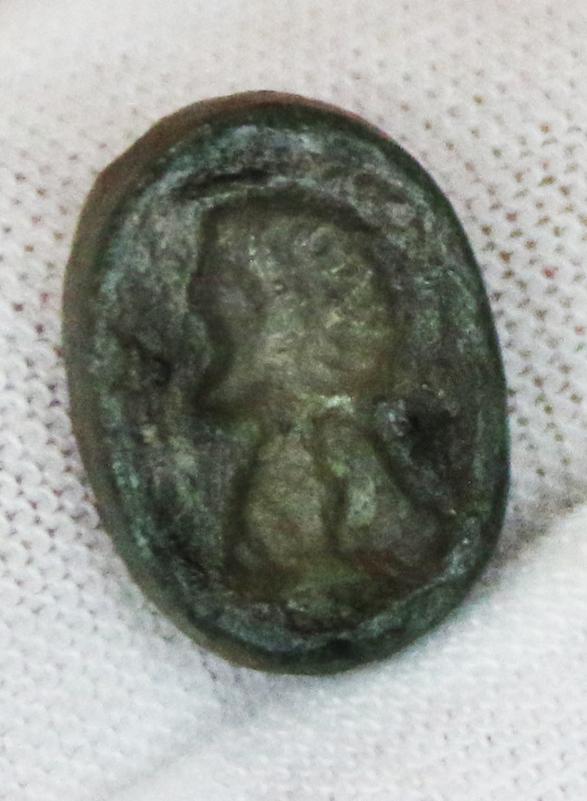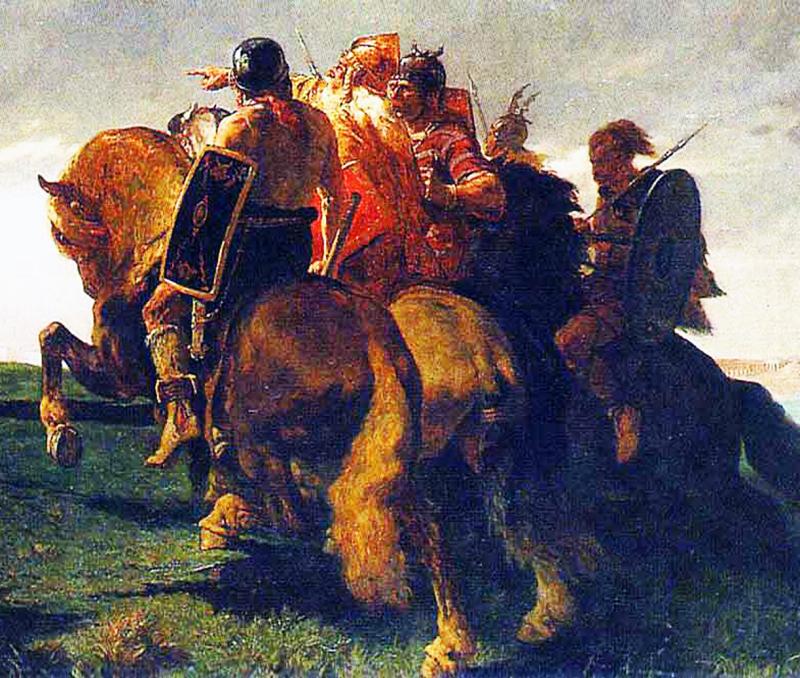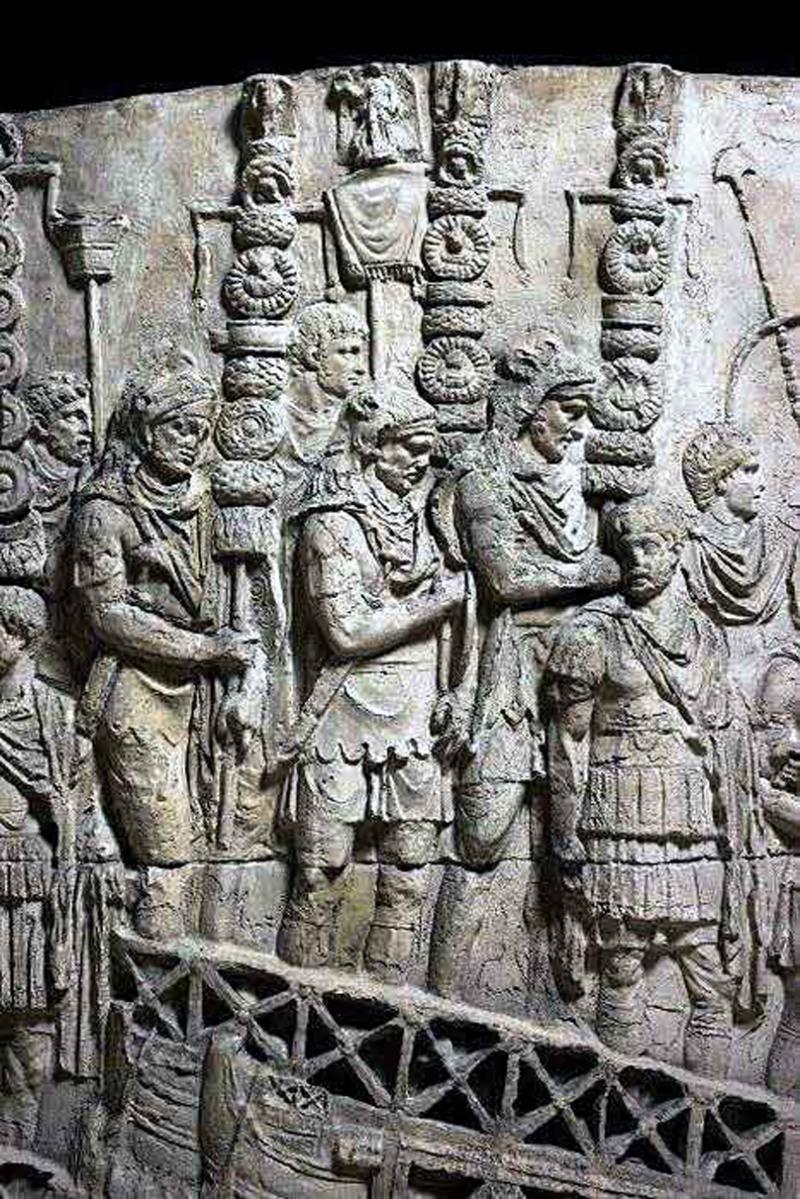1st 2nd Century Romano British Ellipsoid Glass Ring Mount Depicting the Impressed Head of the Sky God of Thunder Taranis {Roman,Jupiter} or Mithras {Roman, Mars} Of the East of England Mithraic Cult. From the Era of 'King' Caratacus
For a man of high status in Romano-British life, a status ring insert of the portrait bust of Taranis or Mithras, with his distinctive bearded profile. He was often found on Romano British brooches, discovered in archaeological digs in Britain, mounted upon his horse. This portrait could have once been set within a ring or a neck pendant. Naturally it could be set once more into a ring mount for current wear.
The wearing of an image of a god or goddess to ward off the evil eye can be traced back to Ancient Greece and the wearing of an image of the Gorgon or Medusa upon a ring or pendant. This practice travelled to Rome and indeed to Roman Britain
Archaeologist Michael Green says, ‘The enamelled brooch is a well-known type from the Catuvellaunian territory. It refers to the Mounted Sky God, whose Romano-Celtic name was probably Taranis {with his distinctive bearded profile}. He survived in local folk lore as Hiccafrith. The local war god was probably Camulos, after whom the Trinovantian capital of Camulodunum was named, at Colchester.’
Quite a few of horse and rider brooches depicting the Sky God Teranis or Mithras, have been found in the East of England, Ipswich, Thetford and one in Lincoln very similar to this portrait bust example, found near Ermine Street along which Roman cavalry travelled bound for Hadrian’s Wall. Two mounted, armed riders were also found as part of a hoard in Willingham Fen, Cambs (now in the Cambridge Museum of Archaeology and Anthropology).
The Catuvellauni were a Celtic tribe or state of southeastern Britain before the Roman conquest, attested by inscriptions into the 4th century.
The fortunes of the Catuvellauni and their kings before the conquest can be traced through ancient coins and scattered references in classical histories. They are mentioned by Cassius Dio, who implies that they led the resistance against the conquest in AD 43. They appear as one of the civitates of Roman Britain in Ptolemy's Geography in the 2nd century, occupying the town of Verlamion (modern St Albans) and the surrounding areas of Hertfordshire, Bedfordshire and southern Cambridgeshire.
Their territory was bordered to the north by the Iceni and Corieltauvi, to the east by the Trinovantes, to the west by the Dobunni and Atrebates, and to the south by the Regni and Cantiaci.
Caratacus is named by Dio Cassius as a son of the Catuvellaunian king Cunobelinus. Based on coin distribution Caratacus appears to have been the protégé of his uncle Epaticcus, who expanded Catuvellaunian power westwards most likely from his palace in Verulam, the heartland of the Catuvellauni, into the territory of the Atrebates. After Epaticcus died in about AD 35, the Atrebates, under Verica, regained some of their territory, but it appears Caratacus completed the conquest, as Dio tells us Verica was ousted, fled to Rome and appealed to the emperor Claudius for help. This was the excuse used by Claudius to launch his invasion of Britain in the summer of 43. The invasion targeted Caratacus' stronghold of Camulodunon (modern Colchester), previously the seat of his father Cunobelinus. Cunobelinus had died some time before the invasion. Caratacus and his brother Togodumnus led the initial defence of the country against Aulus Plautius's four legions, thought to have been around 40,000 men, primarily using guerrilla tactics. They lost much of the south-east after being defeated in two crucial battles, the Battle of the River Medway and River Thames. Togodumnus was killed (although both Miles Russell and John Hind argue that Dio was mistaken in reporting Togodumnus's death, that he was defeated but survived, and was later appointed by the Romans as a friendly king over a number of territories, becoming the loyal king referred to by Tacitus as Cogidubnus or Togidubnus) and the Catuvellauni's territories were conquered. Their stronghold of Camulodunon was converted into the first Roman colonia in Britain,
One can see the very same profile head upon a Romano-British brooch, from the same period, in the British Museum. It is the god Teranis or Mithras on horseback. Aka as Roman gods, Jupiter or Mars
https://www.britishmuseum.org/collection/object/H_1915-1208-119
Size 14mm
Two pictures in the gallery, one a photo of Trajans column of the scene of the Roman Legion standard bearers at the Battle of the River Medway, and a painting of Caratacus and his Brother proceeding to battle the Romans at the River Medway.
Code: 25494
295.00 GBP





